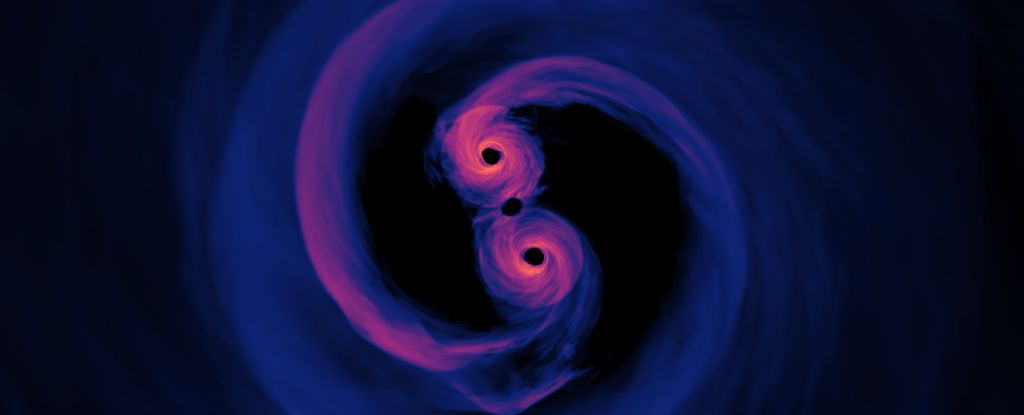Dark matter can provide supermassive black holes the brakes they need to bring them crashing together at the end of a long spiraling journey to their fate.
According to new mathematical modeling, a puzzle known as the finite parsec problem can be solved by the presence of self-interacting dark matter particles that remain clustered around black holes, allowing them to cross the finite distance between them.
It’s a discovery that suggests the mysterious matter that gives the Universe its extra gravity must be able to interact with itself, since the problem can’t be solved with models of non-interacting dark matter.
“We show that including the previously overlooked effect of dark matter can help supermassive black holes overcome this final parsec of separation and merger,” says physicist Gonzalo Alonso-Álvarez at the University of Toronto and McGill University. “Our calculations explain how this can happen, in contrast to what was previously thought.”
Found in the hearts of galaxies, supermassive black holes present astronomers with a huge puzzle. We know that black holes of a smaller size form from the collapsed cores of massive stars that have run out of fusion fuel and hit the cosmic bucket. These smaller measures can be merged into larger ones; the most massive black hole merger discovered to date produced an object with a mass equal to 142 Suns.
Supermassive black holes are millions to billions of times the mass of the Sun. It is reasonable to assume that they could become so large by merging with other monster-sized black holes. We have even observed supermassive black holes circling each other as their galaxies have merged, throughout the history of the Universe, apparently on an eventual collision course.
What is not clear, however, is how these supermassive black holes collide. According to the models, as supermassive black holes orbit each other, they transfer their orbital energy to the stars and gas around them, causing their orbits to become smaller and smaller. As their separation decreases, the amount of things that can steal their moment also decreases.
By the time they are about a parsec apart—3.2 light-years or so—their galactic neighborhood can no longer support further orbital decay, so the black hole’s orbit stabilizes for what may be a period very long time. How long? Well, longer than the Universe has existed for at least.
One way to determine whether supermassive black holes have indeed merged in the past involves gravitational waves; large ripples in the fabric of space-time caused by large masses when they change speed. If supermassive black holes are colliding throughout the Universe, there should be a background “hum” of very low-frequency gravitational waves constantly rippling throughout the Universe.
Finally, we’ve detected some gravitational wave noise in the background. This suggests that we are missing a critical part of the history of the supermassive black hole collision.
This is the ultimate parsec problem.
Dark matter may be what we’re missing. However, according to previous models of merging supermassive black holes, their gravitational interaction should also pull dark matter particles away from the system that might otherwise absorb that last bit of orbital energy.
Now, the problem with dark matter is that we don’t know what it is. It does not interact with the normal matter of the Universe beyond its gravitational pull, making it extremely difficult to probe. We call it dark matter as a catchall term, and scientists are trying to understand its properties by studying the behavior of the Universe in other ways.
frameborder=”0″ allow=”accelerometer; Play automatically; clipboard-write; encrypted media; gyroscope; picture-in-picture; web-share” referrerpolicy=”strict-origin-when-cross-origin” allowfullscreen>
Alonso-Álvarez and his colleagues wondered if we were rushing to throw out dark matter as a solution, so they designed mathematical models to test it. And they found that dark matter interacting with itself can linger in the vicinity of merging supermassive black holes – giving the black holes something to pass their last orbital energy onto, so they can finally hug, forming an extra large supermassive black hole.
At the moment, the results are quite theoretical, but they make predictions that can be observed. For example, the findings predict a dampening of gravitational wave background noise, hints of which have already been seen. And the results can also be used to understand the dark matter halos that surround galaxies throughout the Universe, since the particles must interact on a galactic scale to be able to solve the ultimate parsec problem.
Finally, the researchers say their findings represent a new tool for understanding the mysteries of dark matter.
“Our work is a new way to help us understand the nature of dark matter particles,” says Alonso-Álvarez. “We found that the evolution of black hole orbits is very sensitive to the microphysics of dark matter, and this means that we can use observations of supermassive black hole mergers to better understand these particles.”
The research was published in Physical review papers.
